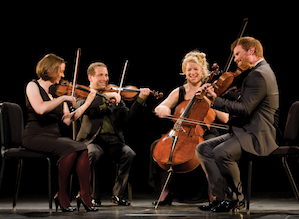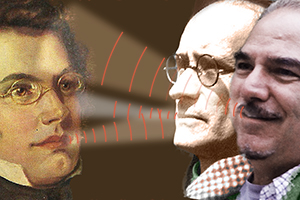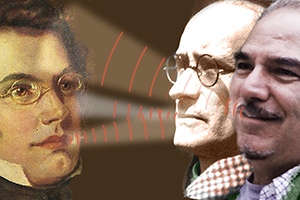
I would have thought the odds of over a hundred high school and middle school students listening in rapt attention to Anton Webern in concert today were about the same as the famous atonal composer writing a piece in C Minor. But such is the success of the Cypress String Quartet’s educational mission that both unlikelihoods were reality at the Marines’ Memorial Theatre in San Francisco Friday night.
For 15 years now, the Cypress Quartet has visited Bay Area schools in their “Call and Response” program, in which the “call” of monuments in musical history, as investigated and elucidated by the Quartet, elicits “responses” from today’s composers and listeners. This year, the monument was Franz Schubert’s Quartet No. 15 in G Major, D. 887. The composer/responder was George Tsontakis, whose String Quartet No. 6 was commissioned and premiered by the Cypress at Friday’s concert. The Cypress (Cecily Ward and Tom Stone, violins; Ethan Filner, viola; and Jennifer Kloetzel, cello) is serious about their work. Their visits to schools are not hasty PR whistle stops, but carefully prepared occasions, as described in the program booklet:
Beginning in early February, teachers receive a curriculum that focuses on the guiding theme of Call & Response. This year, we examined the expansive and concise musical languages of Schubert, Webern, and Tsontakis. We asked students to think about the differences and similarities between haikus and odes, landscape paintings and portrait miniatures, and musical works. Additionally, for the older students, we added a supplemental curriculum that follows the artistic and cultural developments from the Classical through the Modern era.
The concert began with Webern’s so-called Langsamer Satz, a slow movement for a never-completed string quartet that Webern wrote for his teacher Arnold Schoenberg as an exercise in 1905. Inspired by the love for his cousin and later wife, it’s a typical Romantic effusion for its time, beginning in C Minor and moving to E-flat Major. It was in no way comparable in quality or style to Brahms and Mahler, composers mentioned in advertising materials for the sheet music and in the program notes. But I guess a pencil held by Beethoven is better than one held by Heinz Wasmachtergenannt.

Fortunately, the concert continued with Webern’s Five Movements, Op. 5, as masterpiece of expression and concision in the universe of atonality. The work was nicely interpreted by the Cypress players. Given Webern’s milieu, the Quartet’s intonation issues that cropped up elsewhere during the concert were less apparent.
The first half of the concert concluded with Tsontakis’ new quartet. In a fine program essay on his “response” to 15th Schubert Quartet, the composer wrote that the work was as much in response to his own 5th quartet of 2006 (also commissioned by the Cypress) as it was to the “melodic generosity,” nostalgic “waltz feeling,” “sudden dynamic shifts” from counterpoint to “bold choral utterances,” and melodic sequences of Schubert. However, unlike Schubert and his contemporaries’ melodies-on-sleeve, Tsontakis’ melodic impulses in this quartet must be searched for in its garment’s pockets and lining.
What is more important is the agitative links between the Schubert 15 and the Tsontakis 6: Schubert’s opus abounds in ominous tremolos; Tsontakis’ in alternating 16th notes on the interval of a major second—a sort of slowed-down trill. Both techniques heighten tension and are a staple of Romantic sensibility. Although Tsontakis describes the second half of his quartet as “truly fast music,” “relentless,” and a “Blaze,” the effect as I perceived it was less driving. At one point, the slowed-down trill even reminded me of a mosquito buzzing around a room at night.
As Tsontakis explained in person at the event, he was not out to instantly gratify his audience, but rather provide material for future exploration and revisiting—based on the implanting of seeds that will make listeners want to come back. One such element was a dramatically placed glissando chord in the cello on several simultaneous strings, marvelously executed by the Cypress’s Kloetzel. It’s tricks like this that make kids want to find out what the rest of the big top is all about.
In both the Tsontakis, and the Schubert after intermission, the Cypress showed its superior interpretive qualities with rightly chosen tempos and an expressive dynamic range. Their service to the future of music in the Bay Area is immense.

